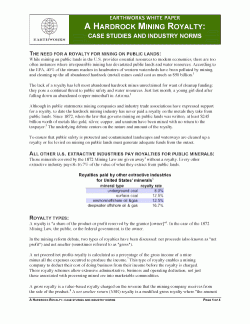A Hardrock Royalty
Case Studies and Industry Norms
Published: October 2, 2007
By: Alan Septoff
From the white paper:
THE NEED FOR A ROYALTY FOR MINING ON PUBLIC LANDS:
While mining on public lands in the U.S. provides essential resources to modern economies, there are too often instances where irresponsible mining has devastated public lands and water resources. According to the EPA, 40% of the stream reaches in headwaters of western watersheds have been polluted by mining, and cleaning up the all abandoned hardrock (metal) mines could cost as much as $50 billion.
The lack of a royalty has left most abandoned hardrock mines unreclaimed for want of cleanup funding; they pose a continual threat to public safety and water resources. Just last month, a young girl died after falling down an abandoned copper mineshaft in Arizona.
Although in public statements mining companies and industry trade associations have expressed support for a royalty, to date the hardrock mining industry has never paid a royalty on the metals they take from public lands. Since 1872, when the law that governs mining on public lands was written, at least $245 billion worth of metals like gold, silver, copper, and uranium have been mined with no return to the taxpayer.
The underlying debate centers on the nature and amount of the royalty. To ensure that public safety is protected and contaminated landscapes and waterways are cleaned up a royalty or fee levied on mining on public lands must generate adequate funds from the outset.
Tagged with: royalty, nevada, net smelter, net proceeds, 1872 mining law

Follow Earthworks